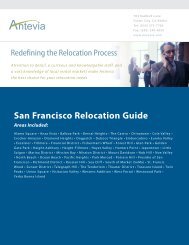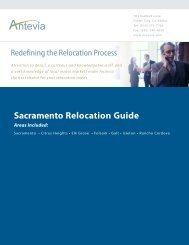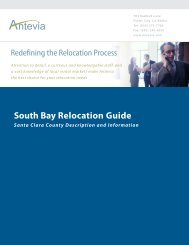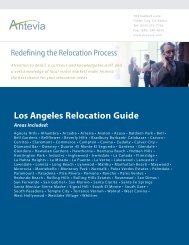Los Angeles Relocation Guide - Antevia
Los Angeles Relocation Guide - Antevia
Los Angeles Relocation Guide - Antevia
- No tags were found...
Create successful ePaper yourself
Turn your PDF publications into a flip-book with our unique Google optimized e-Paper software.
The original inhabitants of Pasadena and surrounding areas was the Native AmericanHahamog-na tribe, a branch of the Tongva (part of the Shoshone language group).Pasadena is a part of the original Spanish land grant named Rancho del Rincon de SanPascual, so named because it was deeded on Easter Sunday to Eulalia Perez de GuillénMariné of the San Gabriel Mission. The Rancho comprised the lands of today'scommunities of Pasadena, Altadena and South Pasadena.Prior to the annexation of California in 1848, the last of the Spanish owners was ManuelGarfias who was allowed to retain title to the property after statehood in 1850. Garfiassold sections of the property to the first white settlers to come into the area, Dr. BenjaminEaton, and Dr. S. Griffin. Much of the property was purchased by the honorableBenjamin Wilson who established his Lake Vineyard property near the vicinity. Wilson,known as Don Benito to the local Indians, was also owner of the Rancho Jurupa(Riverside, California) and went on to become the first Anglo mayor of <strong>Los</strong> <strong>Angeles</strong>. Heis the grandfather of the famous WWII General George S. Patton and would have MountWilson, the metro-media transmission center of the greater <strong>Los</strong> <strong>Angeles</strong> area, named forhim.In 1873 Wilson was visited by one Dr. Daniel M. Berry of Indiana who was looking for aplace in the country that could offer better climate to his patient base, most of whomsuffered from severe respiratory ailments. Berry was an asthmatic himself and claimedthat he had his best three nights sleep at Rancho San Pascual. To keep the find a secret,Berry code-named the area "Muscat" after the grape that Wilson so popularly grew on theproperty. In order to raise funds to bring the company of people to San Pascual, Berryformed the Southern California Orange and Citrus Growers Association for which he soldstock. The newcomers were able to purchase a large portion of the property along theArroyo Seco and on January 31, 1874 they incorporated the Indiana Colony. As a gestureof good will, Wilson threw in the 2,000 acres of thought-to-be-useless highland propertypart of which would become Altadena.Naming PasadenaThe mail came to the Indiana Colony via <strong>Los</strong> <strong>Angeles</strong> so ear-marked. In an attempt toobtain their own Post Office, the Colony needed to change the name to something that thePostmaster General would consider more fitting. The town fathers put up three names toa vote. The first was Indianola. The second was Granada, to be in keeping with the areasSpanish heritage.The third was proposed by Dr. Thomas Elliott who had contacted an Indian missionaryfriend of his in Michigan who had worked with the Minnesota Chippewa Indians. Hesubmitted four names for translation: "Crown of the Valley," "Key of the Valley,""Valley of the Valley," and "Hill of the Valley." The names came back starting with"Weo-quan pa-sa-de-na," "Hat of the Valley" All the names ended in the "pa-sa-de-na (ofthe valley)" translation. The name was put to the vote, and due to its euphonious nature, itwas accepted, thus: Pasadena. Pasadena was incorporated — the second incorporatedmunicipality of Southern California next to <strong>Los</strong> <strong>Angeles</strong> — in March 1886.







